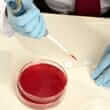Background
- Agar is a natural substance extracted from red seaweeds that are found in waters throughout the world. Agar, a tasteless substance, has been used as a food ingredient for centuries. Agar readily forms a gel and is used as a stabilizer, bulking, thickening and gelling agent, and food additive.
- Agar is a rich source of water-soluble, indigestible fiber. In the digestive tract, it absorbs water, increases bulk, and stimulates large bowel muscle contractions. Agar's most common therapeutic use has been as a laxative, and it has been used for decades as a daily treatment for chronic constipation. Agar is used in a variety of commercial applications, including production of cloth, paper, and cosmetics. More recently, agar has been used in scientific research laboratories to grow bacteria for use in experiments.
- Agar has been studied in several clinical trials as a possible treatment for newborn hyperbilirubinemia, a condition characterized by high levels of the pigment bilirubin in the blood. High levels of bilirubin may result in jaundice, which is a yellow color in the skin and whites of the eyes. Agar has also been investigated to determine if it might have a beneficial effect on glucose intolerance in type 2 diabetes mellitus.
References
- Blum D, Etienne J. Agar in control of hyperbilirubinemia. J Pediatr 1973;83(2):345.
View Abstract - Calvert R, Schneeman BO, Satchithanandam S, et al. Dietary fiber and intestinal adaptation: effects on intestinal and pancreatic digestive enzyme activities. Am J Clin Nutr 1985;41(6):1249-1256.
View Abstract - Dennery PA. Pharmacological interventions for the treatment of neonatal jaundice. Semin Neonatol 2002;7(2):111-119.
View Abstract - Ebbesen F, Moller J. Agar ingestion combined with phototherapy in jaundiced newborn infants. Biol Neonate 1977;31(1-2):7-9.
View Abstract - Holt S, Heading RC, Carter DC, et al. Effect of gel fibre on gastric emptying and absorption of glucose and paracetamol. Lancet 1979;1(8117):636-639.
View Abstract - Kaneko K, Nishida K, Yatsuda J, et al. Effect of fiber on protein, fat and calcium digestibilities and fecal cholesterol excretion. J Nutr Sci Vitaminol (Tokyo) 1986;32(3):317-325.
View Abstract - Maeda H, Yamamoto R, Hirao K, et al. Effects of agar (kanten) diet on obese patients with impaired glucose tolerance and type 2 diabetes. Diabetes Obes Metab 2005;7(1):40-46.
View Abstract - Meloni T, Costa S, Corti R, et al. Agar in control of hyperbilirubinemia of full-term newborn infants with erythrocyte G-6-PD deficiency. Biol Neonate 1978;34(5-6):295-298.
View Abstract - Minekus M, Jelier M, Xiao JZ, et al. Effect of partially hydrolyzed guar gum (PHGG) on the bioaccessibility of fat and cholesterol. Biosci Biotechnol Biochem 2005;69(5):932-938.
View Abstract - Odell GB, Gutcher GR, Whitington PF, et al. Enteral administration of agar as an effective adjunct to phototherapy of neonatal hyperbilirubinemia. Pediatr Res 1983;17(10):810-814.
View Abstract - Osada T, Shibuya T, Kodani T, et al. Obstructing small bowel bezoars due to an agar diet: diagnosis using double balloon enteroscopy. Intern Med 2008;47(7):617-620.
View Abstract - Sanaka M, Yamamoto T, Anjiki H, et al. Effects of agar and pectin on gastric emptying and post-prandial glycaemic profiles in healthy human volunteers. Clin Exp Pharmacol Physiol 2007;34(11):1151-1155.
View Abstract - Schellong G, Quakernack K, Fuhrmans B. [The influence of agar feeding on serum bilirubin in the physiologic jaundice of the newbron [sic] infant (author's transl)]. Z Geburtshilfe Perinatol 1974;178(1):34-39.
View Abstract - Tsai AC, Elias J, Kelley JJ, et al. Influence of certain dietary fibers on serum and tissue cholesterol levels in rats. J Nutr 1976;106(1):118-123.
View Abstract - Wilmshurst P, Crawley JC. The measurement of gastric transit time in obese subjects using 24Na and the effects of energy content and guar gum on gastric emptying and satiety. Br J Nutr 1980;44(1):1-6.
View Abstract







